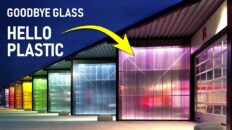“Blind adoration without critique is dangerous”
The Starburst house, a visionary creation by London-based architecture firm Whitaker Studio, has sparked global fascination and made its rounds on social media. Despite being yet unbuilt, it has been listed for a staggering $3.5 million. This 3-bedroom, 3-bath home will sprawl across 2,112 square feet and command an impressive 22.5 acres at the entrance to Joshua Tree National Park.
Designed three years ago for Hollywood movie producers Chris and Roberta Hanley, the house is slated for construction in 2021. Its defining feature is the strikingly angled “view portals,” containers that serve as picturesque frames for the mesmerizing desert and sky vistas.
Architectural success often hinges on striking a balance between the practical and the theoretical, the scientific and the artistic. However, some critics argue that the Starburst house leans too heavily towards impracticality, struggling to achieve that delicate equilibrium. Renderings of the bedroom, for instance, exhibit a large bed spanning the entire width of the container, accessible only by climbing over the headboard. This design aspect raises concerns about functionality.
Interestingly, the design for this house was originally conceived for an office building in Germany, where each container housed desks and a central meeting area. With minimal modifications, the design was transposed into a residential context for Joshua Tree, raising questions about its suitability for a home environment.
Notably, Chris and Roberta Hanley previously constructed the “Invisible House” on a neighboring 90-acre plot. This steel-frame house, sheathed in mirrored, tempered glass, harmoniously integrates with its natural surroundings. By reflecting nature in its façade, the Invisible House pays homage to the primacy of the landscape.
However, critics point out that the structural integrity of shipping containers is compromised when cut or modified extensively. In this case, the container aesthetic seems to outweigh practicality, suggesting that alternative construction methods might have been more appropriate.
It’s essential to foster a healthy discussion around the practicality of such an architectural venture. Critics cite examples of wasteful architecture, like the work of Frank Gehry and Zaha Hadid, who pushed boundaries but faced accusations of inefficiency. Blind adoration without critique is cautioned against, urging us to delve into the details and form informed opinions about such designs.
In conclusion, the Starburst house represents a daring vision, but its practicality and environmental impact warrant thorough consideration. As discussions continue, it’s crucial to weigh the balance between creative ingenuity and sustainable functionality for architectural endeavors like this one.
Sources
https://www.whitakerstudio.co.uk/





